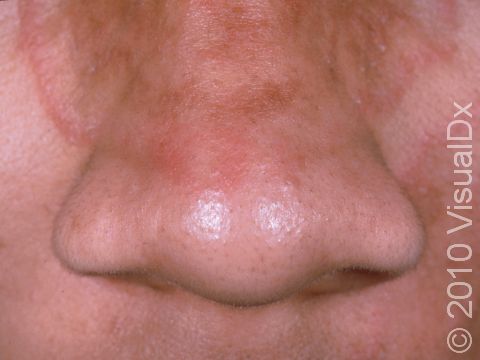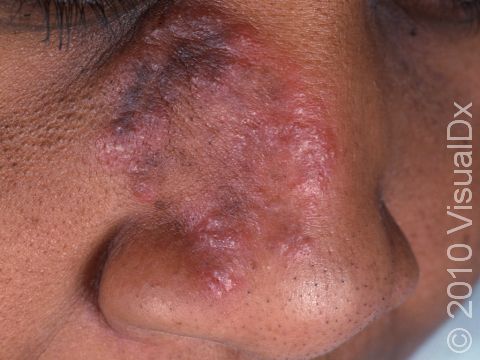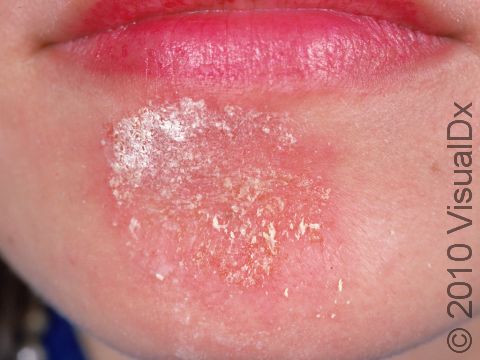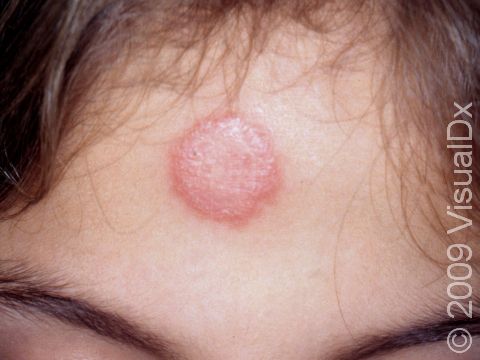Facial Ringworm (Tinea Faciei)
Tinea faciei, commonly known as facial ringworm, is a common fungal infection of the superficial skin of the face. Facial ringworm may be spread by direct contact with infected people, infected animals, contaminated objects (such as towels), or the soil.
In children and most women, facial ringworm can appear on any part of the face. In men and in women who have dark, course hair on their face, it is known as beard ringworm (tinea barbae) when the infection occurs on the bearded part of the face.
Who's At Risk?
Facial ringworm may occur in people of any age, race / ethnicity, or sex. However, it is more common in people who live in warm, humid climates. In addition, it is most frequently seen in adults aged 20-40.
People with suppressed immune systems (eg, with diabetes, leukemia, or HIV / AIDS) are more likely to develop facial ringworm or to have more severe forms of the disease.
Signs & Symptoms
The most common locations for facial ringworm include the:
- Cheeks.
- Nose.
- Around the eye.
- Chin.
- Forehead.
Facial ringworm appears as one or more scaly plaques (raised areas of skin larger than a thumbnail) of any size. In lighter skin colors, the border can be pink or red, whereas in darker skin colors, it can be dark red, purple, brown, or grayish. The border of the affected skin may be bumpy and may contain papules (small, solid bumps), vesicles (fluid-filled bumps), or crust. Often, the center of the lesion has normal-appearing skin with a ring-shaped edge, leading to the nickname “ringworm,” even though it is not caused by a worm.
Facial ringworm can be itchy, and it may worsen or feel sunburned after exposure to the sun.
Self-Care Guidelines
If you suspect you have facial ringworm, you can try one of the following over-the-counter antifungal creams or lotions, such as:
- Terbinafine.
- Clotrimazole.
- Miconazole.
Apply the cream to each lesion and to the skin 2 cm beyond the border of the affected area until the skin completely clears. Because ringworm is very contagious, avoid contact sports until lesions have been treated for at least 48 hours.
People often have tinea infections on more than one body part, so examine yourself for other ringworm infections, such as in the groin (tinea cruris, or jock itch), on the feet (tinea pedis, or athlete’s foot), and anywhere else on the body (tinea corporis).
Have any household pets evaluated by a veterinarian to make sure they do not have a fungal infection. If the veterinarian discovers an infection, be sure to have the animal treated.
Treatments
To confirm the diagnosis of facial ringworm, your medical professional may scrape some scales onto a glass slide and examine them under a microscope. This procedure, called a KOH (potassium hydroxide) preparation, allows the medical professional to look for signs of fungal infection.
Once the diagnosis of facial ringworm is confirmed, your medical professional will likely prescribe an antifungal medication. Most infections can be treated with prescription-strength topical creams and lotions, such as:
- Terbinafine.
- Clotrimazole.
- Miconazole.
- Econazole.
- Oxiconazole.
- Ketoconazole.
- Ciclopirox.
- Sulconazole.
- Naftifine.
Rarely, more extensive or long-standing infections may require treatment with oral antifungal pills, such as:
- Terbinafine.
- Itraconazole.
- Griseofulvin.
- Fluconazole.
The ringworm should go away within 4-6 weeks after using effective treatment.
Visit Urgency
If the lesions do not improve after 1-2 weeks of applying an over-the-counter antifungal cream, see a medical professional for an evaluation.
References
Bolognia J, Schaffer JV, Cerroni L. Dermatology. 4th ed. Philadelphia, PA: Elsevier; 2018.
James WD, Elston D, Treat JR, Rosenbach MA. Andrew’s Diseases of the Skin. 13th ed. Philadelphia, PA: Elsevier; 2019.
Kang S, Amagai M, Bruckner AL, et al. Fitzpatrick’s Dermatology. 9th ed. New York, NY: McGraw-Hill Education; 2019.
Paller A, Mancini A. Paller and Mancini: Hurwitz Clinical Pediatric Dermatology. 6th ed. St. Louis, MO: Elsevier; 2022.
Last modified on June 18th, 2024 at 7:57 am

Not sure what to look for?
Try our new Rash and Skin Condition Finder





